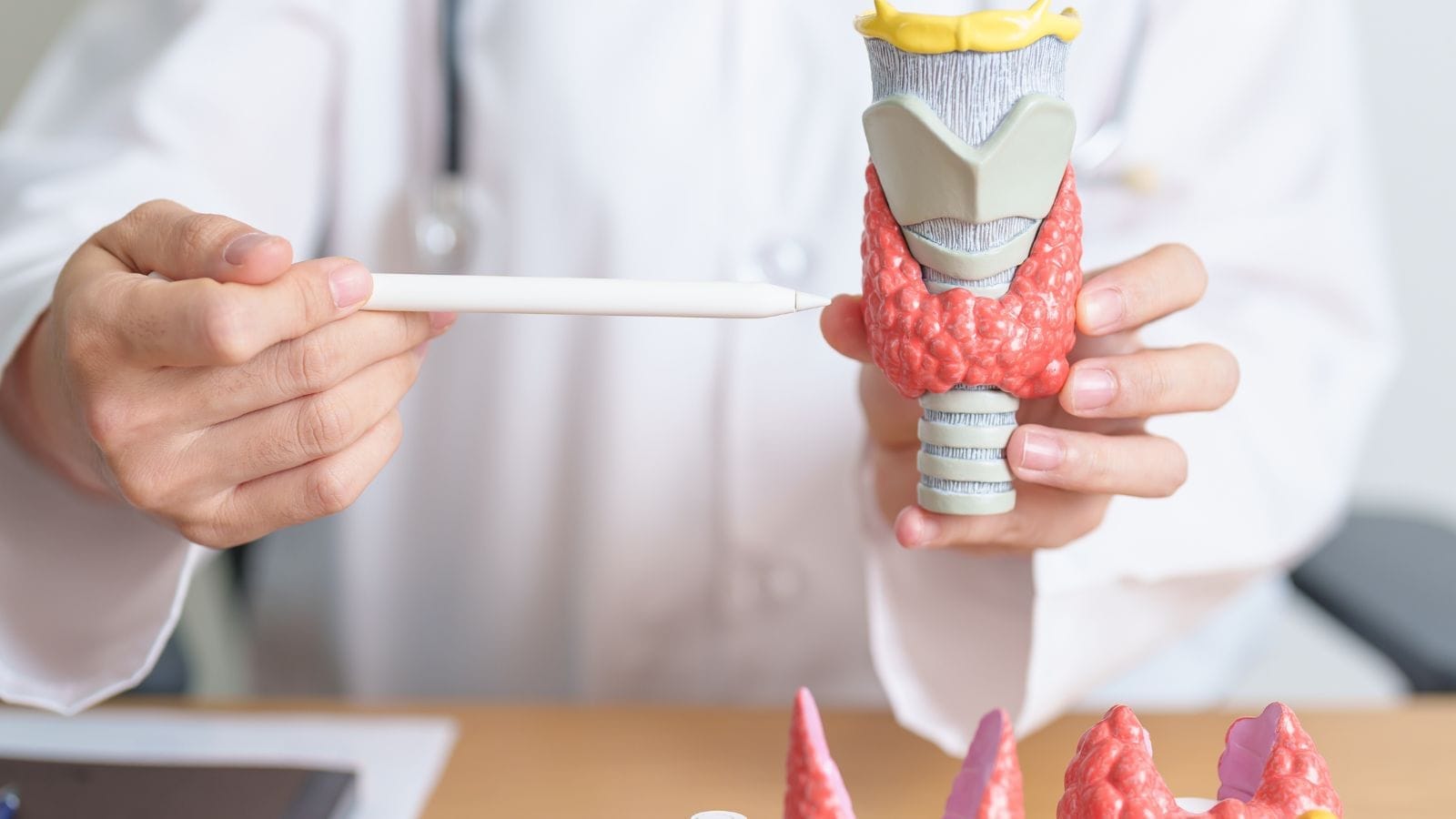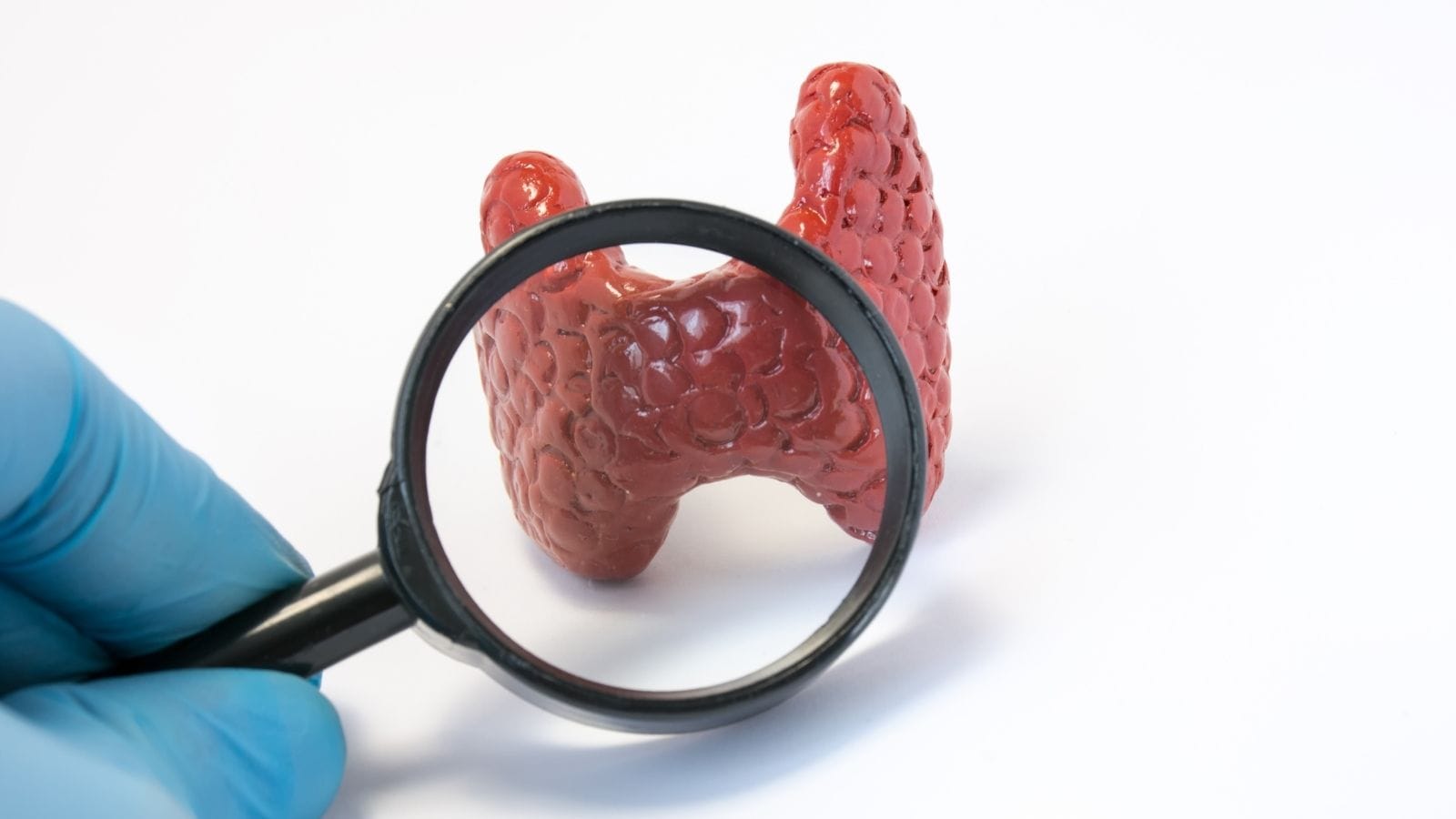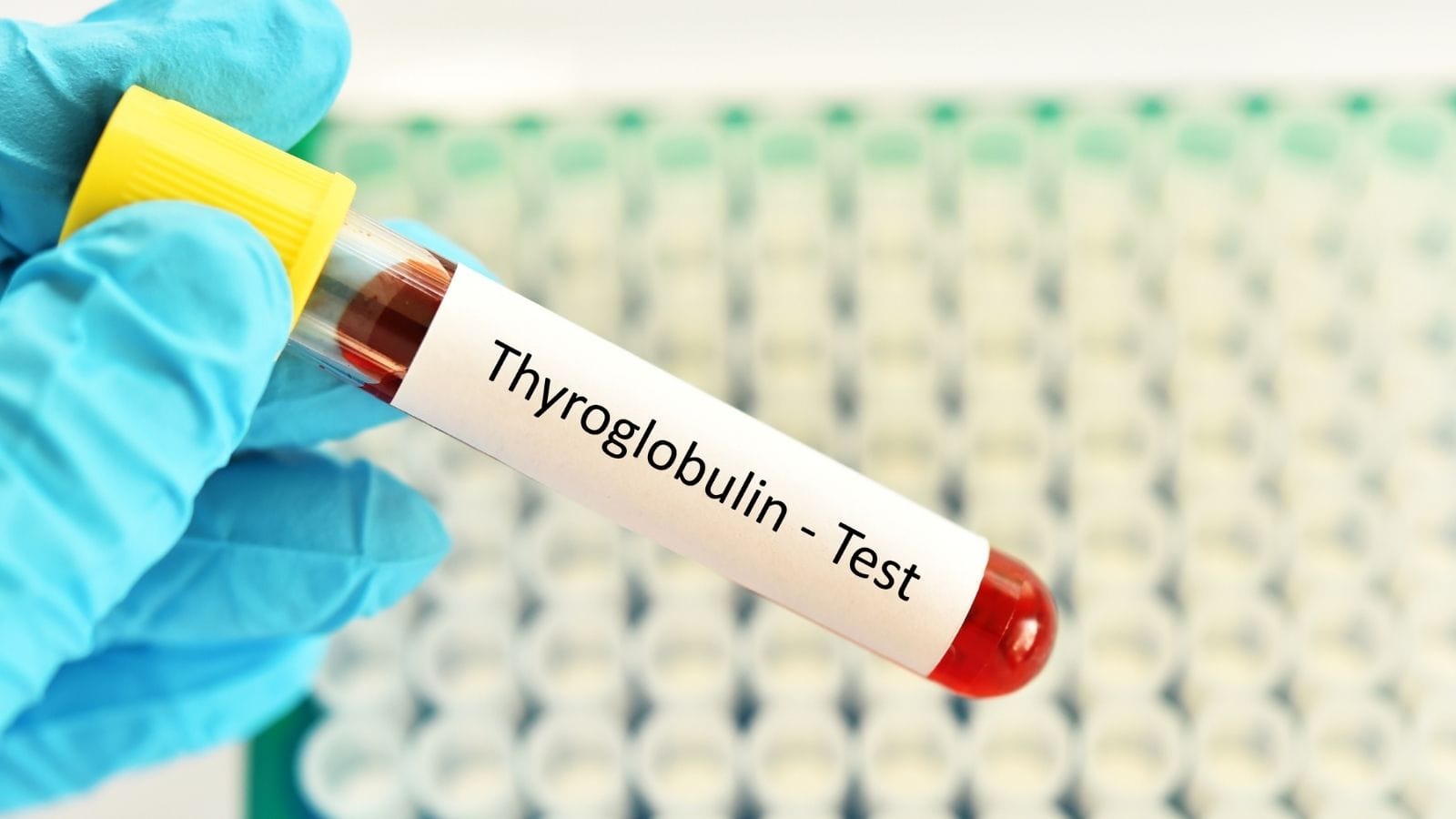Follicular thyroid cancer develops from follicular cells that produce thyroid hormones. It accounts for 10–15% of thyroid cancers and is more common in middle-aged women, often presenting as a solitary thyroid nodule.
This cancer tends to spread through the bloodstream rather than lymph nodes. Common metastasis sites include lungs and bones, which may complicate treatment if diagnosis is delayed.
Surgery is the main treatment, often followed by radioactive iodine therapy to target residual cancer cells. Lifelong thyroid hormone replacement is usually required after total thyroidectomy.
Prognosis is generally favorable with early diagnosis and treatment. Regular follow-up with blood tests and imaging ensures long-term disease monitoring and timely detection of recurrence.
| Disease Name | Follicular Thyroid Cancer |
| Definition | A type of thyroid cancer arising from the follicular cells of the thyroid gland, rare but can have an aggressive course. |
| Symptoms | Painless mass or swelling in the neck, hoarseness, difficulty swallowing or breathing (in advanced cases), neck or throat pain. |
| Causes | Genetic factors, iodine deficiency, radiation exposure, family history of thyroid cancer may play a role in disease development. |
| Risk Factors | Advanced age, female gender, low iodine levels, radiation exposure, family history of thyroid cancer. |
| Diagnostic Methods | Physical examination, thyroid ultrasound, blood tests (T3, T4, TSH), fine-needle aspiration biopsy (for diagnosis), radioactive iodine scan, PET or CT/MRI imaging. |
| Treatment Methods | Surgery (total or subtotal thyroidectomy), radioactive iodine therapy (to prevent spread or destroy residual cells), hormone replacement therapy, rarely radiotherapy or chemotherapy. |
| Follow-up and Monitoring | Regular measurement of thyroglobulin, neck ultrasound, and radioactive iodine scans if necessary after treatment. |
| Complications | Spread of cancer to neck lymph nodes or other organs, risk of recurrence, hoarseness (after surgery), hypothyroidism (after thyroidectomy). |
| Prognosis | Prognosis is generally good with early diagnosis and treatment; however, treatment is more complex in patients diagnosed late or at advanced stages. |
| Prevention Methods | Adequate iodine intake, avoiding radiation exposure, regular check-ups and screenings for those with a family history of thyroid cancer. |
Prof. Dr. Özgür KILIÇKESMEZ Prof. Dr. Kılıçkesmez holds the Turkish Radiology Competency Certificate, the Turkish Interventional Radiology Competency Certificate, Stroke Treatment Certification, and the European Board of Interventional Radiology (EBIR). In his academic career, he won the Siemens Radiology First Prize in 2008.
Interventional Radiology / Interventional Neuroradiology
What Is Follicular Thyroid Cancer?
Follicular thyroid cancer originates from the follicular cells of the thyroid gland and is included in the differentiated thyroid cancer group. This cancer type constitutes 10–15% of all thyroid cancers and is more common in regions with iodine deficiency. It usually presents as a slowly growing solitary thyroid nodule. However, compared to other thyroid cancers, it has a higher likelihood of vascular invasion. This characteristic increases the risk of the cancer metastasizing to distant areas, particularly the lungs and bones. Although the risk of lymph node spread is low, the tendency to invade blood vessels increases the likelihood of distant organ metastasis, which is significant in disease progression.
What Are the Causes of Follicular Thyroid Cancer?
Follicular thyroid cancer (FTC) results from the interaction of various genetic and environmental factors. Genetic mutations play an important role in this cancer type. Most FTC cases are associated with mutations in the RAS gene family or PAX8-PPARγ gene fusion. These mutations abnormally activate signaling pathways controlling cell growth, accelerating tumor development.
Additionally, activation of the PI3K/AKT signaling pathway is a critical factor in the formation of FTC. Inactivation of the PTEN tumor suppressor gene and mutations in PIK3CA and AKT1 genes contribute to this process. Environmental factors are also important; iodine deficiency is a strong risk factor for FTC. In areas with insufficient iodine, goiter formation is more common and can lead to FTC development.
Hormonal influences also play a role among the causes of FTC. Excessive activation of thyroid-stimulating hormone (TSH) can cause uncontrolled growth of thyroid cells. Additionally, some microRNAs have been found to be abnormally expressed in FTC cases. These microRNAs affect genes regulating cell growth and contribute to cancer progression.
Other genetic factors are also important in the development of FTC. Mutations in tumor suppressor genes such as p53 and changes in oncogenes like c-myc and c-fos increase the aggressiveness and metastatic potential of the cancer.
How Common Is Follicular Thyroid Cancer?
Follicular thyroid cancer (FTC) accounts for 10–15% of all thyroid cancer cases, making it a significant type of thyroid cancer. Its prevalence varies depending on factors such as age, gender, and geographic region. FTC is generally more common in women than in men, a trend seen globally, with women having about three times the prevalence. It is also more frequently diagnosed in individuals aged 45–65, with the average age at diagnosis being around 51. The highest incidence in women is observed in the 55–59 age group, while this age range varies slightly in men.
The prevalence of FTC also differs significantly across geographic regions. Particularly, more cases are reported in areas with high iodine levels, while fewer cases are seen in regions with iodine deficiency.
- Incidence rates: 0.5 to 2.5 cases per 100,000 people per year.
- Gender differences: Three times more common in women than men.
- Age factor: Most common between ages 45–65; average diagnosis age is 51.
- Geographic distribution: More frequent in areas with higher iodine levels.
The increase in FTC incidence is associated with improved detection methods and increased awareness. Lifestyle factors such as obesity and radiation exposure also contribute to this trend.
*We recommend filling out all fields so we can respond in the best possible way.
What Is the Development Process of Follicular Thyroid Cancer?
The development of follicular thyroid cancer occurs through a complex interaction of genetic and environmental factors. First, genetic mutations play a key role in the development of this cancer. Mutations in the Ras oncogene family are found in most FTC cases, accelerating cell proliferation and contributing to tumor formation. Chromosomal abnormalities such as the PAX8-PPARγ fusion protein can also support the growth of follicular thyroid cancer.
Environmental factors also influence the development of this cancer. Iodine deficiency is a significant risk factor in regions where FTC is more prevalent. Iodine deficiency encourages follicular cell hyperplasia, increasing cancer development. Childhood radiation exposure is another important risk, as it can trigger mutations in thyroid cells and lead to cancer formation.
The histological features of FTC also explain how the tumor develops. This cancer originates from follicular epithelial cells and is characterized by encapsulation. Signs of vascular or capsular invasion determine whether the tumor is malignant.
What Are the Symptoms of Follicular Thyroid Cancer?
Follicular thyroid cancer is often difficult to diagnose in early stages because it may not present noticeable symptoms. As the disease progresses, some symptoms begin to appear. The most common is a palpable mass or nodule in the neck. As the tumor grows, patients may begin to feel pain, especially in the neck, jaw, or ear. Tumors located near the vocal cords may cause hoarseness.
Larger tumors can press on the esophagus, causing difficulty swallowing. Similarly, pressure on the trachea can lead to shortness of breath. These symptoms may become more severe as the disease advances. Swelling of the lymph nodes may occur if the cancer spreads to them.
Some patients may develop a persistent cough, especially if there is no respiratory infection. If the cancer metastasizes, different symptoms may occur depending on the location, such as bone pain if it spreads to the bones.
These symptoms do not always indicate cancer, but persistent and unusual symptoms require further investigation, especially in those with risk factors.
How Is Follicular Thyroid Cancer Diagnosed?
The diagnosis of follicular thyroid cancer (FTC) is made using a combination of various methods. Fine-needle aspiration (FNA) biopsy is frequently used in the evaluation of thyroid nodules, but in FTC, this method may not definitively distinguish between follicular adenoma and carcinoma because demonstration of capsular or vascular invasion is required for a definitive diagnosis.
The definitive diagnosis is usually made by histopathological examination of tissue obtained after surgical intervention. Detection of invasion signs in this examination is crucial, which is why FTC is diagnosed after surgical resection.
Imaging methods also play an important role in the diagnostic process. Ultrasound is widely used to evaluate the structure and features of a thyroid nodule. Radioactive iodine scans can help detect the spread of FTC due to its ability to uptake iodine.
The diagnostic methods used include:
- Fine-Needle Aspiration (FNA) Biopsy: May be limited in definitive diagnosis of FTC.
- Surgical Resection and Histopathology: Diagnosis is made by detecting capsular and vascular invasion.
- Imaging: Ultrasound and radioactive iodine scans are commonly used.
- Radioactive Iodine Uptake: FTC cells’ ability to uptake iodine plays an important role in diagnosis.
- Molecular Tests: Tests such as RAS gene mutations may support diagnosis.
These methods are used together to ensure accurate diagnosis of FTC.
How Is Follicular Thyroid Cancer Treated?
In cases where traditional methods are insufficient, interventional radiology offers an important treatment option for follicular thyroid cancer. These minimally invasive techniques are especially effective in advanced or recurrent cases. When used as an alternative to surgery, they provide targeted treatment with fewer side effects. The chance of successful treatment increases in advanced cases or patients resistant to radioactive iodine.
The main interventional radiology techniques include:
- Radiofrequency Ablation (RFA): Destroys cancer cells by generating heat with electrical energy. Widely used for metastatic lesions.
- Cryoablation: Destroys cancerous tissue by freezing and is suitable for patients where minimal thermal damage is needed.
- Ethanol Ablation (Percutaneous Ethanol Injection – PEI): Alcohol is injected into the tumor to kill cancer cells; applied for small nodules or local recurrences.
- Selective Arterial Embolization: Cuts off the blood supply to metastatic lesions to stop their growth; can be combined with other treatments like chemotherapy.
These methods are generally preferred for patients who cannot undergo surgery or are not good surgical candidates. They also help control the spread of cancer and improve quality of life, especially offering safe and effective treatment options for high-risk surgical patients.
What Are the Risk Factors for Follicular Thyroid Cancer?
There are several risk factors for follicular thyroid cancer (FTC), including demographic, biological, and clinical features. Age and gender play an important role, with FTC being more common in adults over 45. Patients over 55 have a higher risk of distant metastasis and death, and men have poorer outcomes compared to women.
The characteristics of the tumor also affect risk. Tumors larger than 4 cm are associated with higher invasiveness and extrathyroidal spread, increasing the risk of recurrence and death. Tumors that invade blood vessels are also high risk.
- Advanced age and male gender are associated with worse outcomes.
- Tumors larger than 4 cm present higher risk.
- Tumors invading blood vessels are more dangerous.
- Metastasis to the lungs and bones leads to lower survival rates.
Individuals living in areas with low iodine intake are at greater risk for FTC, but there is no clear association between excessive iodine intake and follicular thyroid cancer. Genetic factors also play a key role; hereditary conditions such as Cowden syndrome and familial adenomatous polyposis (FAP) increase the risk. Childhood radiation exposure significantly increases the risk of thyroid cancer.
When Can Follicular Thyroid Cancer Treatment Be Performed?
Treatment for follicular thyroid cancer can be performed using interventional radiology techniques when surgery is not possible or carries high risk. These methods are especially valuable for patients who are unsuitable for surgery due to advanced age or serious health problems. Ablation techniques may be an effective alternative for patients who cannot undergo or refuse surgery.
In cases of recurrent thyroid cancer where traditional surgery is not feasible, interventional radiology techniques can be used to reduce tumor size and control regional recurrences. Thermal ablation techniques such as radiofrequency ablation and microwave ablation are effective in these patients.
Additionally, interventional radiology treatments can be applied in cases of localized small metastases. Particularly for small metastases in the bones and lungs, minimally invasive techniques can control metastatic lesions without the need for systemic therapy.
When Is Follicular Thyroid Cancer Treatment Not Possible?
Radiofrequency ablation (RFA) may not be applicable in certain cases of follicular thyroid cancer. Some important factors should be considered here. First, proximity to critical structures can prevent the use of RFA; if the tumor or nodule is close to vital structures, the procedure is risky. Pregnancy is also an important contraindication, as RFA carries risks that may harm the fetus. Large tumor size also affects the applicability of this treatment, as RFA is not effective in large or extensive tumors. Patients with serious comorbidities may not benefit from this method. Finally, cystic nodules are better treated with alcohol ablation than RFA. These factors should be kept in mind.
What Is the Recovery Process After Follicular Thyroid Cancer Treatment?
The recovery process after follicular thyroid cancer treatment requires careful management to maintain overall patient health. This process usually depends on the treatment method applied. Key aspects of recovery include:
- Pain Management and Recovery: Pain after ablation is usually mild. Patients may experience localized discomfort and swelling in the treated area. Resting for the first few days and limiting physical activity is an important part of recovery. Afterwards, patients can gradually return to normal activities.
- Monitoring for Complications: Postoperative monitoring plays a critical role in the early detection of complications such as infection, bleeding, or injury to surrounding tissues. Regular imaging is needed to evaluate treatment effectiveness.
- Thyroid Hormone Replacement: Ongoing monitoring may be necessary depending on the functional capacity of the remaining thyroid tissue after treatment. If some thyroid tissue remains, patients may need hormone replacement, although less than in surgical cases.
- Radioactive Iodine (RAI) Considerations: RAI therapy may be administered after ablation to target residual cancer cells. This is usually planned a few weeks or months after ablation, and protocols should be in place to help patients cope with side effects.
- Rehabilitation and Long-Term Monitoring: Rehabilitation strategies are important for scar management and improving neck mobility. Physical therapy and speech therapy, if necessary, play a key role in recovery. Long-term monitoring with regular exams and blood tests helps control recurrence.
How Can Follicular Thyroid Cancer Be Prevented?
Prevention of follicular thyroid cancer involves addressing modifiable risk factors and improving early detection strategies. First, high-risk individuals should undergo regular screening. Genetic screening is important for those with a family history or known genetic mutations, facilitating early detection. Balancing iodine intake is also crucial, as adequate intake maintains thyroid health.
Another key point is to avoid radiation exposure, especially during childhood, as it increases thyroid cancer risk. Unnecessary medical radiation should be avoided. Individuals with thyroid nodules should seek timely medical evaluation, and rapidly growing nodules should be assessed early to reduce the risk of malignancy.
A personalized approach is essential for managing recurrence risk, especially in cases with large tumors or positive surgical margins. Healthy lifestyle changes such as a balanced diet and regular exercise are also recommended for overall health.
Frequently Asked Questions
How is follicular thyroid cancer diagnosed?
Follicular thyroid cancer (FTC) accounts for about 10–15% of all thyroid cancers in the United States. Diagnosis is generally made using a combination of physical examination, imaging studies, and fine-needle aspiration (FNA) biopsy. However, FNA cytology often cannot distinguish benign follicular adenomas from FTC. A definitive diagnosis typically requires surgical removal of the thyroid nodule to evaluate for capsular or vascular invasion, which are signs of malignancy. Additional imaging techniques such as ultrasound and radioactive iodine scans are used to assess the extent and detect metastasis. Early and accurate diagnosis is vital for effective management and improving the prognosis of FTC.
How is this cancer type different from other thyroid cancers?
Follicular thyroid cancer (FTC) makes up about 10–15% of all thyroid cancers in the US, while papillary thyroid cancer is more common (70–80%). Papillary thyroid cancer usually spreads to the neck lymph nodes, whereas FTC tends to metastasize to distant organs, especially the lungs and bones, via the bloodstream. The overall 5-year survival rate for FTC is about 91%, and the 10-year survival rate is 85%, but these rates vary by stage: 100% for stages I and II, 71% for stage III, and 50% for stage IV. Anaplastic thyroid cancer is very rare (<2%) but highly aggressive, with much lower survival rates. Medullary thyroid cancer accounts for about 2% of thyroid cancers, can be familial, and is associated with other endocrine tumors. In general, thyroid cancer makes up 2.2% of all new cancer cases in the US, with 44,020 new cases and 2,170 deaths estimated for 2024. The overall 5-year relative survival rate for thyroid cancer is 98.4%, but this varies greatly depending on cancer type and stage.
What are the treatment options for follicular thyroid cancer?
Follicular thyroid cancer accounts for about 10–15% of all thyroid cancers in the US, and treatment options include surgery, radioactive iodine therapy, thyroid hormone therapy, external beam radiation therapy, and targeted therapies. Surgery typically involves lobectomy (removal of one lobe) or total thyroidectomy (removal of the entire thyroid gland), depending on the size and spread of the tumor. Radioactive iodine therapy is used after surgery to destroy remaining thyroid tissue or cancer cells, especially when the cancer has spread. Thyroid hormone therapy is given to replace normal hormones and suppress TSH levels, which could stimulate cancer growth. External beam radiation therapy may be an option for cancers that do not respond to radioactive iodine or have spread. Targeted therapies, such as tyrosine kinase inhibitors like sorafenib and lenvatinib, are used in advanced cases that do not respond to other treatments. The 5-year survival rate is 99.5% for localized FTC, 98.3% for regional spread, and 63.2% for distant metastasis.
What is the risk of recurrence after treatment?
The recurrence rate for follicular thyroid cancer (FTC) after treatment is about 13.6%, with distant metastasis seen in approximately 64.8% of these cases. Major risk factors for recurrence include age over 45, tumor size greater than 4 cm, vascular invasion, multifocal disease, positive surgical margins, lymph node involvement, and the presence of distant metastasis at diagnosis. FTC is more likely than other thyroid cancers to metastasize distantly via the bloodstream. Regular follow-up and individualized treatment strategies are important for managing recurrence risk.
What screening methods are recommended for early detection of follicular thyroid cancer?
Recommended screening methods for early detection of follicular thyroid cancer (FTC) include palpation of the neck during physical examination and high-resolution ultrasound imaging to identify thyroid nodules. If a nodule is found, fine-needle aspiration biopsy (FNAB) is performed to obtain tissue samples for cytological analysis. However, distinguishing FTC from benign follicular adenomas by FNAB alone is difficult due to similar cellular appearances. Immunohistochemical staining for markers such as galectin-3 and HBME-1 can increase diagnostic accuracy, as their presence is associated with malignancy. Advanced molecular testing for cancer-related genetic mutations and DNA methylation profiles also improves preoperative diagnostic accuracy. The use of artificial intelligence techniques in interpreting imaging and histopathological data is also being developed to further improve early detection and diagnosis.

Girişimsel Radyoloji ve Nöroradyoloji Uzmanı Prof. Dr. Özgür Kılıçkesmez, 1997 yılında Cerrahpaşa Tıp Fakültesi’nden mezun oldu. Uzmanlık eğitimini İstanbul Eğitim ve Araştırma Hastanesi’nde tamamladı. Londra’da girişimsel radyoloji ve onkoloji alanında eğitim aldı. İstanbul Çam ve Sakura Şehir Hastanesi’nde girişimsel radyoloji bölümünü kurdu ve 2020 yılında profesör oldu. Çok sayıda uluslararası ödül ve sertifikaya sahip olan Kılıçkesmez’in 150’den fazla bilimsel yayını bulunmakta ve 1500’den fazla atıf almıştır. Halen Medicana Ataköy Hastanesi’nde görev yapmaktadır.









Vaka Örnekleri